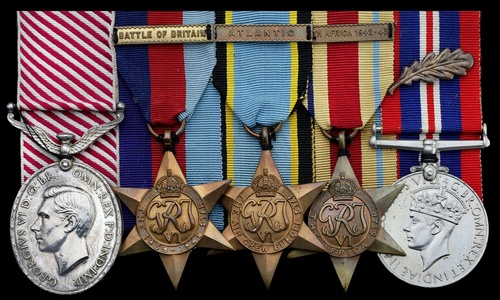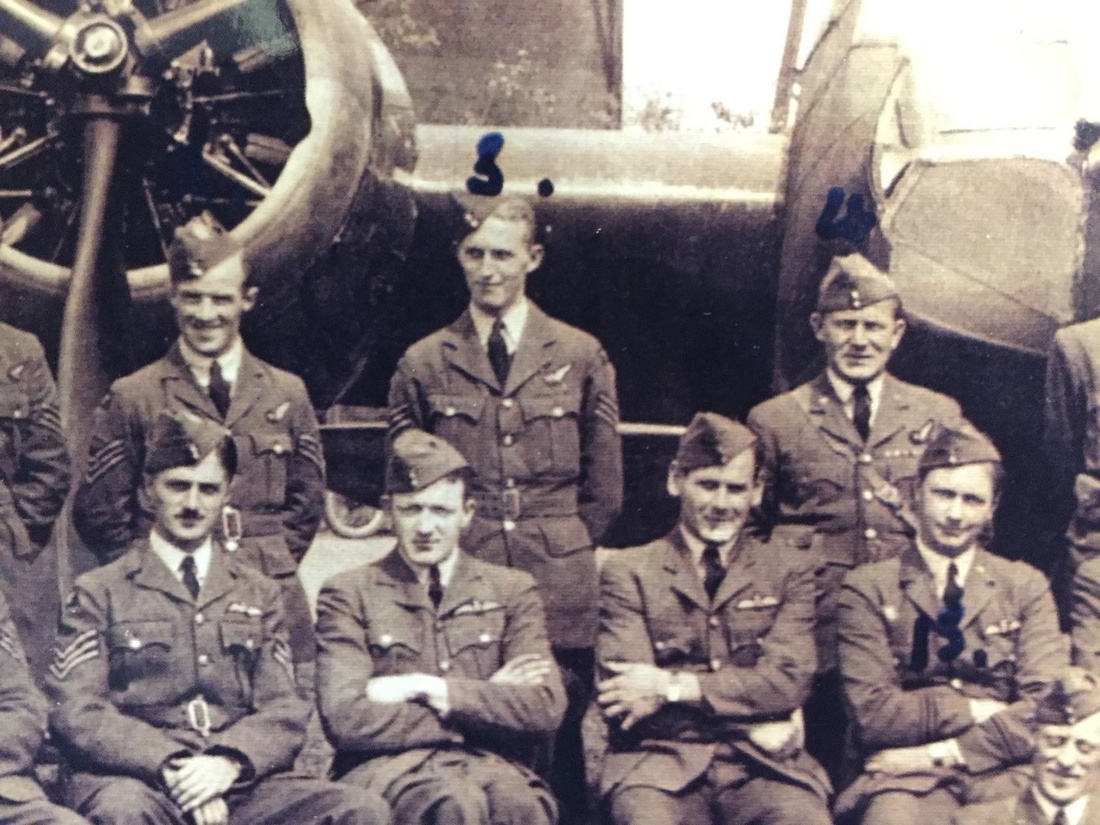Auction: 20001 - Orders, Decorations and Medals - conducted behind closed doors
Lot: 752
A rare Battle of Britain veteran's A.F.M. group of five awarded to Flight Lieutenant C. Beveridge, Royal Air Force
Having flown a tour of night operations as an Observer / Air Gunner in Blenheims of No. 219 Squadron in August-September 1940, he converted to Beaufighters as a newly qualified Radar / Navigator and undertook numerous sorties out of Tangmere in the period leading up to November 1941
He subsequently became a highly skilled - and much in demand - Flight Engineer in Liberators and Yorks of No. 511 Squadron, undertaking one of the first direct flights to Egypt and back; nor were such flights of an ordinary nature, his squadron often being charged with the safe delivery of a string of VIPs to overseas conferences
He was thus employed in conveying such notables as Air Chief Marshal Sir Arthur Tedder to the Cairo conference attended by Churchill, Roosevelt and Chiang Kai-shek in November 1943
He also conveyed Air Chief Marshal Sir Charles Portal, General Sir Alan Brooke, Admiral Sir Andrew Cunningham, General Sir John Dill and General Sir Hastings Ismay from Habbaniya to the famous Teheran conference later in the same month
Awarded the A.F.M. - one of just two such distinctions granted to ex-Battle of Britain aircrew - and commissioned in August 1943, Beveridge ended the war on like duties in No. 24 Squadron, and added a mention in despatches to his accolades
Air Force Medal, G.VI.R. (522807 F./Sgt. C. Beveridge, R.A.F.); 1939-45 Star, copy clasp, Battle of Britain; Air Crew Europe Star, clasp, Atlantic; Africa Star, clasp, North Africa 1942-43; War Medal 1939-45, M.I.D. oak leaf, good very fine (5)
A.F.M. London Gazette 1 January 1944. The original recommendation states:
'This airman has shown exceptional skill as a Flight Engineer. He was employed in that capacity on one of the first direct flights from the U.K. to Egypt and Egypt to the U.K. His devotion to duty, both during the flights and on the ground at overseas staging posts, where he had to depend on himself and his resources, has set a fine example.'
Charles Beveridge was born in London on 7 June 1915 and enlisted in the Royal Air Force as an aircraft hand in August 1935.
No. 219 Squadron - The Battle
Having then re-mustered for training as an Air Gunner at Manbury on the Isle of Man, he was re-classified as a Leading Aircraftsman (A.G.) and was posted to No. 219 Squadron at Catterick on 1 August 1940. Then commanded by one of colourful Atcherley brothers - Squadron Leader R. L. R. 'Batchy' Atcherley - the unit was equipped with Blenheim 1F night fighters.
Teaming-up with a Canadian pilot, P./O. Jean Carriere, Beveridge undertook his first operational patrol on 2 August 1940 and flew two further sorties on the same date. Between then and late September, he undertook around a dozen such sorties but, with night fighter capabilities then in their infancy, they do not appear to have fought any combats.
But the dangers inherent in such operations became painfully apparent on the night of 6 August, when Carriere flew into high tension cables and crashed into a river. He was admitted to hospital but Beveridge nursed his resultant facial injuries back at base. He was back on operations on 4 September and carried out further sorties with Pilot Officers William Lambie and Geoffrey Head, in addition to Sergeants Henry Grubb, Harold Crook and Robert Sergeant.
In October, 219 Squadron was re-equipped with Beaufighters and Beveridge attended relevant course to acquaint him with Air Interception (A1) equipment. Duly qualified as a Radar Operator - and having flown his last sortie in a Blenheim on 12 October - he went operational in a Beaufighter on the following night, flying a three-hour sortie over London; by this stage the Squadron had moved south to Redhill but airfield was not suitable and subsequent sorties were flown out of Kenley.
With the Battle of Britain over, 219 moved to Tangmere, from whence Beveridge remained operational until November 1941. He was advanced to Sergeant.
No. 511 Squadron - VIPs
During the summer of 1942, Beveridge retrained as a Flight Engineer and, in October, emerged as a qualified Flight Sergeant Engineer with an 'E' Brevet. He was posted to No. 511 Squadron, a Transport Command unit operating in Liberators and Yorks.
Initially employed on maintaining a service between England and Gibraltar, the unit later extended its reach to Malta and Egypt. The delivery of supplies aside, Beveridge and his fellow aircrew soon established a reputation for VIP flights, following Churchill's famous Casablanca conference in January 1943. His own part in such operations is duly recorded in the Squadron's O.R.B. but it was mainly for his skilful work in opening-up the Egypt route that he was awarded his A.F.M.
In so far as Malta and Gibraltar were concerned, 511's records reveal that Beveridge and his crew picked up 30 passengers from the besieged island and, on 4 July 1943, visited 'The Rock' on a supply run. General Sikorsky's aircraft came to grief immediately after take-off from Gibraltar on the very same day, so Beveridge may well have been called upon to assist in the recovery of wreckage and bodies.
And his part in VIP flights was a significant one, incorporating as they did such important gatherings as the Heads of State conferences held at Teheran and Cairo in 1943. The cast of his notable passengers - en route for vital talks with the likes of Churchill, Roosevelt and Stalin - makes for heady reading. Some of them are listed above but with further names of note apparent - such as Sir Anthony Eden - we may be sure that Beveridge was kept busy.
As Flight Engineer, he was the only member of crew not permanently strapped to his seat during flight, and he would have been responsible for checking that his distinguished passengers were comfortable; Churchill often played cards with his flight crew during such trips.
Having completed his 39th and final flight in No. 511 Squadron in December 1943, Beveridge transferred to like duties in No. 24 Squadron in the following year. In September 1944, his flying log book was endorsed with the following 'green ink' commendation:
'This officer was posted to the Squadron for duty as a Flight Engineer and has flown on all overseas flights undertaken by the Special York Aircraft MV 100. He has shown great zeal and devotion to duty throughout, and his efficiency has contributed materially to the success of the flights undertaken.'
He was mentioned in despatches (London Gazette 14 June 1945, refers).
Granted the substantive rank of Flight Lieutenant in February 1947, Beveridge finally retired from the R.A.F. in September 1951. He died in Chichester, Sussex on 18 December 1984; sold with a file of comprehensive research, together with two or three original photographs of VIPs, among them Churchill and H.M. the King.
Subject to 20% VAT on Buyer’s Premium. For more information please view Terms and Conditions for Buyers.
Sold for
£4,800
Starting price
£3000







